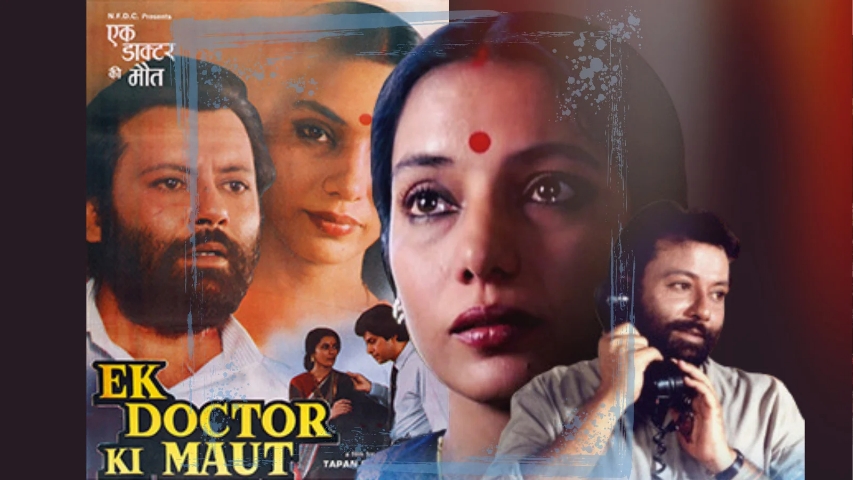
ALTERNATIVE ENTERTAINMENT: TAPAN SINHA’S EK DOCTOR KI MAUT
by O.P. Srivastava March 6 2024, 12:00 am Estimated Reading Time: 4 mins, 36 secsTapan Sinha’s Ek Doctor Ki Maut (1990) shows how scientific research and innovation is not given its due in India, and how professional jealousy and insensitive government machinery can kill any independent research initiative, writes O.P. Srivastava.
The film is based on the story Abhimanyu by Ramapada Chowdhury, and it stars Pankaj Kapoor, Shabana Azmi, Anil Chatterjee, Irrfan Khan, Deepa Sahi and Vijayendra Ghatge.
Subodh Roy did the cinematography and edited the film, while Vanraj Bhatia composed its music. The film was produced by the NFDC. It has a running time of 122 minutes.
Ek Doctor Ki Maut was widely applauded for its well-written screenplay and direction as well as Pankaj Kapoor’s performance as Dr Dipakar Roy. Ably supported by Shabana Azmi, Anil Chatterjee and Irrfan Khan, Kapoor flawlessly expresses the genuine passion and devotion of a scientist towards his research and his struggle with the corrupt and callous administrative machinery that strangulates the development of independent research initiatives in our country.
The film received three National Film Awards in 1991: Best Direction, Second Best Film, and the Special Jury Award for Kapoor. The film also garnered the 1992 Filmfare Best Screenplay Award for Sinha.
The film is set in the 1970s or ‘80s, when the sarkari babu culture was at its peak. It traces the journey of a doctor who has sacrificed 10 years of his life to work on a vaccine for leprosy. His obsession with his research is so strong that he often neglects his own health and family. After several years of arduous work, when he finally achieves his goal, he is made to run from pillar to post to make his discovery known to the world, all due to the machinations and jealousy of his peers and the insensitiveness of the government machinery. As a result, he loses his claim to his discovery, which is hijacked by international conglomerates.
This film is inspired by the real-life story of Dr Subhash Mukhopadhyay, who was denied the credit due to him for his achievement in the field of in vitro fertilization. He lost the title of inventor to a foreigner merely because of the delay and uncooperative attitude of bureaucrats and the scientific fraternity. Dr Mukhopadhyay was the second person in the world to succeed with in vitro fertilization and the first in India. Kanupriya Agarwal (Durga) was born in 1978, India’s first child conceived via in vitro fertilisation, just 67 days after the first IVF baby was born in the United Kingdom. Dr Mukhopadhy committed suicide on 19th June 1981. It is said that his discovery was mired in the bureaucratic jungle, causing a delay in the submission of his claim to international authorities for registration of a patent claim.

The film makes you empathize with Dr Roy and wonder how many such brilliant initiatives have been suppressed because of the callousness and rigidity of our insensitive system. This was, and probably still is, the reason academically brilliant people leave India to join foreign universities and institutes, never to return. Consequently, our country must pay a heavy price for such talent migration.
Sinha (2nd October 1924–15th January 2009), one of the most prominent film directors of his time, formed a legendary quartet with Satyajit Ray, Ritwik Ghatak and Mrinal Sen. He started his career in 1946, as a sound engineer with the New Theatres film production house in Kolkata. In 1950, he travelled to England, where he worked at Pinewood Studios for the next two years before returning to start his six-decade long career in Indian cinema, making Bengali, Hindi and Oriya films across an entire gamut of genres: literary adaptations like Kabuliwala and Kshudhita Pashan, swashbuckling adventures like Jhinder Bandi, rip-roaring comedies and satires like Golpo Holeo Satti, Ek Je Chilo Desh and Bancharamer Bagan, contemporary socio-political dramas like Apanjan, Atanka, Adalat O Ekti Meye, period pieces like Sagina and films for children like Sobuj Dwiper Raja and Aaj Ka Robinhood. Over his prolific career, Sinha received 14 National Film Awards as well as the Dadasaheb Phalke Award in 2006. He was conferred with the Padma Shri in 1992.
Ek Doctor Ki Maut was a parallel cinema film released in 1990; the only other parallel film made that year was Mrinal Sen’s Ek Din Achanak. The market was dominated by the din of commercial films like Agneepath (Amitabh Bachchan, Mithun Chakraborty), Aashiqui (Rahul Roy, Anu Agarwal) and Ghayal (Sunny Deol, Meenakshi Seshadri). Even parallel cinema filmmakers like Govind Nihalani (Drishti) and Sai Paranjape (Disha) had started using commercial stars to improve the financial viability of their films.
The films we see today that blur the line between parallel and mainstream cinema are successors of those produced by Sinha in the 1970s. Sinha has often been described, even by his contemporaries, as one of the finest ‘middle-of-the-road’ filmmakers in the country. Mrinal Sen once said, ‘We differed in many ways and I did not agree with him all the time, but that does not mean that I do not consider him one of the finest directors in India. I have also never found a human being as good and as powerful as Tapan Sinha’.
Many of Sinha’s films were adapted by eminent Hindi film directors, the most well-known being Hemen Gupta’s version of Kabuliwala (1961), produced by Bimal Roy. In it, Balraj Sahni gave one of his best performances. The next adaptations of Sinha’s films came in 1971 and 1972 with Gulzar’s Mere Apne and Hrishikesh Mukherjee’s Bawarchi.




-173X130.jpg)
-173X130.jpg)
-173X130.jpg)
-173X130.jpg)
-173X130.jpg)
-173X130.jpg)
-173X130.jpg)
-173X130.jpg)